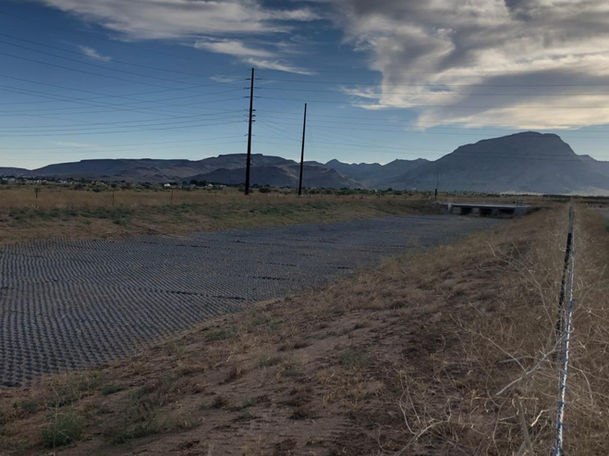Need help selecting the right FLEXAMAT? Use our Product Recommender.

Blindage des canaux de contrôle des inondations
Afin de faciliter le développement futur d'une plaine inondable existante, la Ville a travaillé avec le district de contrôle des inondations pour élaborer un rapport complet sur le plan directeur de drainage de zone. La zone d’étude s’étendait sur environ 85 milles carrés et était située dans le désert de Mohave. Le Plan directeur de drainage a été élaboré pour répondre à quatre objectifs principaux :
1. Évaluer et identifier les risques d'inondation et les problèmes de drainage dans la zone du projet par la mise en œuvre d'un plan de travail qui comprend la collecte de données, l'examen des études précédentes, la collecte d'informations auprès des agences publiques et des résidents, la modélisation hydrologique et hydraulique.
2. Développer une série d'alternatives pour atténuer partiellement ou totalement les dangers identifiés dans le premier objectif.
3. Mener une analyse culturelle et environnementale de bureau pour les solutions conceptuelles afin d'identifier leurs impacts potentiels sur les problèmes de drainage
4. Assurer la coordination des parties prenantes et la sensibilisation du public au projet par le biais d'une réunion publique et de plusieurs réunions des parties prenantes du projet.
Les résultats de l'étude ont été utilisés comme outil de planification et comme contribution à la conception de futures infrastructures de drainage potentielles et de mesures d'atténuation des inondations adaptées à l'environnement physique pour le développement actuel et futur. Sur la base de ces données, un plan a été élaboré pour créer un canal de contrôle des crues afin d'ouvrir les terres des plaines inondables pour un développement futur. Cela a nécessité la construction d'un canal de 4 800 pieds de long. Les ingénieurs du district d'inondation avaient besoin d'un contrôle permanent de l'érosion du canal et cherchaient une alternative à l'enrochement rocheux. Les ingénieurs ne considéraient pas l'enrochement comme une solution permanente, sachant que la roche se déplacerait souvent après de fortes pluies et constituerait un problème d'entretien continu pour le district inondable. L'emplacement du projet dans le désert de Mojave a créé des défis de conception uniques ; cette région est connue comme l'un des climats les plus rigoureux au monde.
Le désert de Mojave est bordé par le désert du Grand Bassin au nord et par le désert de Sonora au sud et à l'est. Le désert de Mojave contient l'endroit le plus bas et le plus chaud d'Amérique du Nord : la Vallée de la Mort, à 86 m sous le niveau de la mer, où la température dépasse souvent 49 °C (120 °F) de fin juin à début août. Le Mojave est un désert de températures extrêmes et de deux saisons distinctes. Les mois d'hiver apportent des températures diurnes confortables, qui descendent parfois jusqu'à environ 25 °F (−4 °C) au fond des vallées, et en dessous de 0 °F (−18 °C) aux plus hautes altitudes. Les tempêtes venant du nord-ouest du Pacifique peuvent apporter de la pluie et même de la neige à certains endroits. Le temps printanier continue d’être influencé par les tempêtes du Pacifique, mais les précipitations sont moins répandues. À la mi-juin, la saison de la mousson commence dans le désert de Mohave. L'humidité de la mousson crée des orages de la mi-juin au début septembre.
En raison du climat extrême, les ingénieurs de Flood District avaient besoin d'un produit capable de résister à ces conditions difficiles. Un système de confinement cellulaire a été spécifié pour protéger le canal d'inondation contre l'érosion future, également connu sous le nom de géocellules. Les systèmes de confinement cellulaire typiques sont des géosynthétiques fabriqués avec des bandes de polyéthylène haute densité (PEHD) soudées par ultrasons ou un nouvel alliage polymère (NPA) - et expansés sur place pour former une structure en nid d'abeille - et remplis de sable, de terre, de roche, de gravier ou béton. Les ingénieurs du Flood District ont spécifié Flexamat 10-NW comme alternative au confinement cellulaire/géocellule. Flexamat 10-NW est un tapis de contrôle de l'érosion en blocs de béton liés. Ce tapis d'érosion en béton comprend une sous-couche géotextile non tissée de 10 onces.
L'entrepreneur au plus bas prix pour ce projet a déterminé que Flexamat 10-NW représenterait une économie de travail et de temps importante par rapport à l'installation du système de confinement cellulaire/géocellule. Le tapis anti-érosion en béton a été fabriqué sur le site du projet, réduisant considérablement les coûts de transport.

























